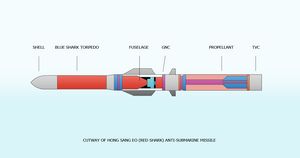Ananti-submarine missile is a standoff anti-submarine weapon, often a specialized variant of anti-ship missile. Anti-submarine missile usually include a jetorrocket engine and a warhead aimed directly at a submarine. In these missiles, a torpedo or a depth charge is used as a warhead.


Depth charges were the earliest weapons designed for use by ships against submerged submarines. These explosives were initially dropped as the ship moved over the presumed location of a submarine. Before World War II, shipboard sonar was unable to maintain contact with a submarine at close range.
Various mortar-type projectors, including Hedgehog and Squid, were devised during World War II to allow a ship to maintain sonar contact while lobbing explosive charges toward the submarine.[1]
During the Cold War, missiles were developed to provide greater range with reduced recoil. Some missiles and rockets, such as Red Shark carry homing torpedoes to provide terminal guidance for the warhead.[2]
The advantage of an anti-submarine missile is the attack stand-off range. The Swedish Bofors 375mm m/50 Anti-Submarine Warfare (ASW) rockets, in the past commonly used by Sweden, France, Japan and Germany for instance, can travel as far as 3600m depending on the rocket used.[3] The USSR developed its own anti-submarine rockets in the RBU series and these are still in use in Russia and in countries using Russian designed ships. Today anti-submarine rockets have been phased out in most western navies, replaced by the Homing ASW Torpedo.